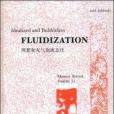《理想和無氣泡流態化》是2009年2月1日科學出版社出版的圖書,作者是Mooson Kwauk、Youchu Li。
基本介紹
- 中文名:理想和無氣泡流態化
- 作者:Mooson Kwauk、Youchu Li
- 出版社:科學出版社
- 出版時間:2008-12
- 頁數:353 頁
- 定價:138 元
- ISBN:9787030224422
內容介紹,作者簡介,圖書目錄,
內容介紹
《理想和無氣泡流態化》主要內容:When fluidization was first employed industrially,e.g., in the Winkler gasifier, we had only the bubblingfluidized bed as shown in the middle diagram of thefigure, in which gas bypasses as bubbles, thus leadingto poor solid-gas contact and incurring large pressuredrop. What is ideal is the high dispersion of solidsshown asthe background of the book jacket. Short ofsuch an ideal state, we may resort to suppressing bubblesby the use of shallow fluidized bed as shown on thelefthand side diagram achieved through reducing thesolid content of the fluidized bed. or the fast fluidizedbed with continuous recycfing of solids to the bottomof the bed, as shown on the righthand side diagram. Allthese diagrams of fluidization were generated throughcomputer modeling by Professor Wei Ge, and fromhosts of these diagrams, four were selected by Xue Bai,Jianxing Lu and Ying Ren to portray the principal thesisof this book.
作者簡介
編者:(美國)Mooson Kwauk (美國)Youchu Li
Mooson Kwauk graduated from University of Shanghai in1 943 and researched in fluidization under the late ProfessorRichard Wilhelm at Princeton University from 1 945 to1947.He has continued working in this field both in theUnited States and in China,and iS now Professor andDirector Emeritus of the Institute of Process Engineering ofthe Chinese Academy of Sciences,to which he was electedMember in 1980.In 1989 he received an InternationalFluidization Award of Achievement at the Sixth International Fluidization Conference held in Banff,Canada.
The author postulates an idealized system of completehomogeneity that can be used in the analysis of many engineering problems,e.g.,
·generalized fluidization with both solids and fluid in flow
·fluidized leaching and washing
·solids mixing and segregation
·operation of conical fluidized beds
These problems arise in hydraulic classification according to particle size anddensity,sedimentation and classification,continuous ion exchange or adsorption,watertreatment,fluid-bed electrolysis,and biochemical processes involving granular particlesand supercritical extraction of solid materials.Professor Kwauk also expoundsalternative bubbleless gassolid contacting systems,e.g.,dilute raining particles,fastfluidization,shallow fluidized beds,and particles fluidized under the influence ofoscillating flowsome of these techniques are already replacing their bubblingpredecessors.He proposes further a method for assessing the fluidizing performance ofpowders with a view to improving their gas-solid contacting behavior in the direction ofthe idealized state through particle design.
Youchu Li graduated from Tianjin University in 1962 andwas appointed to the Institute of Chemical Metallurgy(nowProcess Engineering)of the Chinese Academy of Sciences.He is now a retired professor.As a researcher and directorof the Fluidization Laboratory,he developed correlations forthe dynamics of fast fluidization,multilayer fluidized bed,gas—solid mixing,mass and heat transfer in fluidization,andhe developed processes for magnetizing roasting of low-grade and complex iron ores,calcination of non-metallicores,clean coal combustion and pyrolysis and preparation ofvarious powdered functional materials.
Professor Li received several awards from the State and the Chinese Academv ofSciences,and he summarized in 2008 his more than 40 years’R&D in fluidization in amonograph,“Introduction to Fluidization Process Engineering”(in Chinese).In thepresent publication,he contributed two addenda:one on recent studies on gas-solid flowand applications of fast fluidization and the other on the more recent area of magnetoflu—idization,both involving not a few of his own innovations.
Chapter 1 THE FLUIDIZED STATE
Chapter 2 IDEALIZATION OF THE FLUIDIZING PROCESS: Empirical Deductions from L/S Systems
Chapter 3 GENERALIZED FLUIDIZATION
Chapter 4 FLUIDIZED LEACHING AND WASHI NG
Chapter 5 SOLIDS MIXING AND SEGREGATION
Chapter 6 CONICAL FLUIDIZED BEDS
Chapter 7 APPLICATION OF THE MOVING BED
Chapter 8 BUBBLELESS GAS/SOLID CONTACTING
Chapter 9 SYSTEMS WITH DILUTE RAINING PARTICLES
Chapter 10 VOIDAGE DISTRIBUTION IN FAST FLUIDIZATION
Chapter 11 SHALLOW FLUIDIZED BED
Chapter 12 FLUIDIZATION WITH NO NET FLUID FLOW
Chapter 13 A COHERENT ANALYSIS FOR L/S AND G/S SYSTEMS
Chapter 14 POWDER ASSESSMENT
Chapter 15 FUTURE PROSPECTS
NOTATIONS
References
SUBJECT INDEX
ADDENDA

